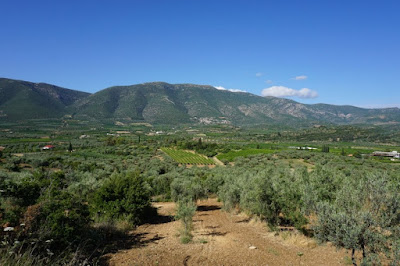The Western Argolid Regional Project (WARP) has just concluded its
second field season. Whereas in the 2014 season the project surveyed in
the area of the modern village of Lyrkeia, which sits on the northern
edge of a wide open mountainous river valley, the 2015 season focused on
the lower reaches of the Inachos river as the valley begins to flatten
out and open up into the Argive plain, in the territories of the modern
villages of Schinochori and Malandreni.

Over the course of six weeks (3 June -- 14 July), our six field teams
intensively surveyed 6.8 square kilometers in 2,699 survey units,
criss-crossing the sometimes rough and rocky terrain of this year's
survey area. Like last year, we found a wide variety of artifacts and
sites, from the Early Bronze Age to the Modern period, with Archaic to
Hellenistic predominating. The total artifact density for 2015 was about
two thirds of that from the 2014 field season. This is very surprising
considering that (1) we were operating in such close proximity to Argos
(about 10 km) and (2) this year's survey area is a much more actively
utilized modern landscape, with many more field houses (kalyvia),
threshing floors (alonia) and other agricultural installations. Many of
these were no longer in use, giving us an opportunity to do some
targeted survey and study of abandoned modern buildings. At next year's
annual meeting of the AIA we'll be presenting a paper based in large
part on this year's work entitled "Roads, Routes and Abandoned Villages
in the western Argolid" as part of a colloquium on deserted villages
organized by Deb Stewart and Kostis Kourelis.

Our team was bigger than last year's: we added an extra field team and
in total there were 22 field walkers, evenly split between students from
Wilfrid Laurier University (Scott's home institution) and the
University of Colorado Boulder (Sarah's home institution). They
patiently endured the less fun parts of the Greek landscape, like
spiders and ankle-turning fields of weeds, with good cheer, and even
embraced the challenge of walking directly up rocky slopes! We were
lucky to retain almost all of our graduate students from the 2014
season, so students were expertly guided by a remarkable group of very
experienced, intelligent, and hard-working team leaders.

Like last year, we took students on field trips to sites in the
northeastern Peloponnese, including the CIG excavations at Stymphalos,
but there were some changes, too: this year we went as a team to a
performance at the Epidauros theatre. We saw a riveting performance of
Euripides' "Trojan Women" by the National Theatre of Greece. To help us
appreciate the play, Professor John Gibert (University of Colorado
Boulder) visited the project for just over a week and gave presentations
on ancient theatre (in the ancient theatre of Argos) and on the "Trojan
Women" specifically. Also unlike last year, this year we were joined by
some new staff: Ioanna Antoniadou, an archaeologist and anthropologist
who worked with the team for eight weeks as the project's ethnographer,
and Joe Desloges and Pamela Tetford, fluvial geomorphologists who
studied the Inachos river and its effects on the landscapes of the
western Argolid. These specialists are fleshing out our understanding of
the recent past and the present of the local communities with and
around whom we work, as well as the geological past and present of the
region. Although these studies are still preliminary, they have already
helped the project immeasurably, not only for research but also for
student training.
For more information on WARP, please visit our project website and blog at westernargolid.org!
Dimitri Nakassis
University of Toronto





No comments:
Post a Comment